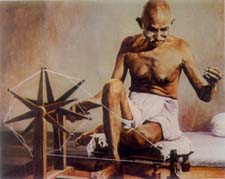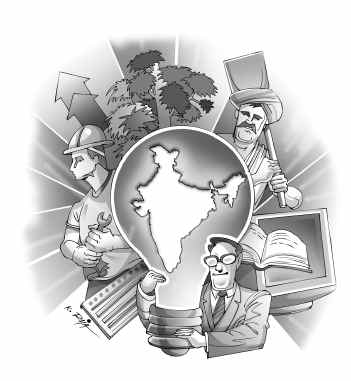Category: Global Economy Sub-category: Indian Economy
Document type: article
 In the center of India's flag, sits a spinning wheel - a symbol used by Gandhi to protest English textile imports under colonial rule and to demonstrate the ability of a society of small-scale agriculture and industry. India's economy was governed by the principle of the spinning wheel for much of its independence. On the Indian flag, the spinning wheel adorning India's colors is a powerful testament to the historically vital linkages between India's economy and its political identity. The spinning wheel symbolizes economic and political independence, dearly held values that have driven India's approach to economic policy since Independence.
In the center of India's flag, sits a spinning wheel - a symbol used by Gandhi to protest English textile imports under colonial rule and to demonstrate the ability of a society of small-scale agriculture and industry. India's economy was governed by the principle of the spinning wheel for much of its independence. On the Indian flag, the spinning wheel adorning India's colors is a powerful testament to the historically vital linkages between India's economy and its political identity. The spinning wheel symbolizes economic and political independence, dearly held values that have driven India's approach to economic policy since Independence.
India's independence in 1947 and the appointment of the Indian National Congress party heralded a new era of economic policy dedicated to "self-sufficiency". Often described as the "third way" or "mixed economy", Nehru established a blend of democratic politics and central planning. India's pride in its then evolving economic reforms is best manifested by the following statement attributed to Nehru: "a second-rate Indian good is superior to a first-rate foreign product." Nehru established state ownership and import-substitution industrialization in hopes of developing India's internal capacity.
However, India's socialistic planning failed to develop a strong economy and efficient institutions. Waste and corruption flourished in the country. The state bureaucracy became known as the "License Raj" because its comprehensive scheme of licenses, required for all business activities, created fertile ground for widespread bribes and political kickbacks.
While economic growth rate in many Asian nations surged, India's growth rate was approximating at a sluggish 3% and was deridingly termed as the "Hindu rate of growth".
The 1991 Balance of Payment (BOP) crisis was the "tipping point" in India's economic history. India was forced to procure $1.8 billion loan from the International Monetary Fund (IMF). The bailout wounded India's pride and thwarted the country's policies of "self-sufficiency". India's policy failures were now glaring across the Indian policymakers and the world.
In response to the crisis, the government immediately introduced stabilization measures to reduce the fiscal deficit. Fiscal tightening and devaluation of the rupee by 25% adequately reduced the current account deficit. Though the foreign exchange reserve recovered quickly and ended effectively the temporary clout of the IMF and the World Bank, reforms continued in a stop-go fashion. The government has since initiated a reversal of the historic policies of regulation and government intervention.
The economic liberation reform, initiated by Manmohan Singh in 1991, is considered to be one of the milestones of Indian economic reform as it changed the market and financial scenario of the country. Foreign Direct Investment was encouraged, public monopolies were stopped, and service and tertiary sectors were developed. It was not until 1991 that the government signaled a systematic shift to a more open economy with greater reliance upon market forces, a larger role for the private sector including foreign investment, and a restructuring of the role of the government. In the 10 year period from 1992-93 to 2001-02, the average growth rate of the country was around 6%, which puts India amongst the fastest growing developing economies of the 1990s. (Read More)
External Links:
Economy of India - The Economy of India is the tenth largest in the world by nominal GDP and the fourth largest by purchasing power parity (PPP). The country's per capita GDP (PPP) is $3,339 (IMF, 129th) in 2010. Following strong economic reforms from the post-independence socialist economy, the country's economic growth progressed at a rapid pace, as free market principles were initiated in 1991 for international competition and foreign investment. Despite fast economic growth India continues to face massive income inequalities, high unemployment and malnutrition.
--









